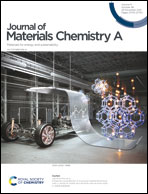A self-assembled hierarchical structure to keep the 3D crystal dimensionality in n-butylammonium cation-capped Pb–Sn perovskites†
Abstract
The structural engineering of crystal frameworks has emerged as a highly useful technique in the development of perovskite solar cells (PSCs) to realize highly efficient devices with superior chemical and electrical properties. The introduction of organic spacer cations into perovskite crystals is one of the major topics currently being explored in the field of structural engineering research. However, intercalated organic molecules in three-dimensional (3D) perovskite structures generate low-dimensional perovskite phases, resulting in inefficient carrier transport due to a reduction in 3D dimensionality. Maintaining the 3D crystal structures of organic-cation-inserted perovskites remains a major issue and a challenging task to be solved. In this work, we created an ideal organic-layered 3D crystal structure using an n-butylammonium (n-BA) halide salt in a FA0.83Cs0.17Pb0.5Sn0.5I3 perovskite. The cation allows a self-assembled hierarchical structure in which the n-BA organic analog is layered on the surface and at the bottom of the perovskite without a reduction of the 3D crystal dimensionality. Based on X-ray scattering results, the existence of a vertically oriented crystal structure, from both external and internal structural perspectives, demonstrates the creation of an ideal n-BA-capped 3D perovskite crystal. Furthermore, the self-assembling n-BA cations facilitate an enhancement of the device stability of Pb–Sn PSCs, due to the suppression of the generation of silver iodide at the top interface and the degradation of PSS in poly(3,4-ethylenedioxythiophene)polystyrene sulfonate (PEDOT:PSS) by sulfuric acid at the bottom interface. These structural and chemical stability effects lead to the creation of a highly efficient Pb–Sn PSC with nearly 19% efficiency.



 Please wait while we load your content...
Please wait while we load your content...